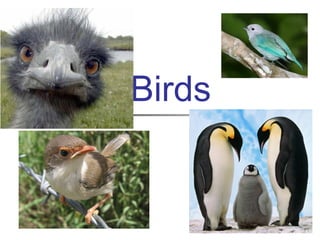
Characteristics of Birds
- 1. Birds
- 2. Characteristics of Birds Feathers Help birds stay dry and warm, attract mates, and fly Preening and Molting Preening: the act of grooming and maintaining their feathers Preening spreads oil over the feathers, which makes them waterproof Molting: process of shedding old feathers and growing new ones Most birds shed once a year
- 3. Two kinds of feathers Down feathers fluffy feathers that lie next to the bird’s body Keep birds warm by trapping body heat next to body Contour feathers stiff feathers that cover a bird’s body and wings Colors and shapes attract mates Streamlined surface helps bird fly
- 4. Fast Digestion Birds eat a lot because they need a lot of energy Birds eat seeds, insects, nuts, and meat because they are high in protein Modern birds don’t have teeth, so they can’t chew Food goes from the mouth to the crop, which stores food until it goes to the gizzard the gizzard has small stones which grind up the food so that it can be easily digested
- 5. Flying Birds have air sacs attached to their lungs to store air Most birds have large eyes and excellent eyesight; birds such as hawks and eagles can see 8 times better than humans can see! Wing shape is related to how a bird flies- short wings for quick turning, long wings for soaring
- 6. Rigid skeleton allows a bird to move its wings efficiently Powerful flight muscle attached to a large breastbone called a keel Birds have hollow bones so that they are light Getting off the ground Air moving around a bird’s wing changes in speed and direction, creating an upward force that keeps a bird in the air “lift” is an upward force on a bird’s wings
- 7. Raising Baby Birds Most birds build nests to lay their eggs Brooding act of sitting on eggs and using body heat to keep them warm
- 8. Some birds are active soon after birth; others are weak and helpless Precocial active chicks, such as chickens and ducks; can stand up and follow parents around Altricial have no feathers and eyes are closed when born; cannot walk or fly at birth, such as hawks and songbirds
- 9. Kinds of Birds Flightless birds Most do not have the large keel that anchors a birds’ flight muscles Some run quickly to move around Others are skilled swimmers Examples: penguins, kiwi, ostrich
- 10. Water birds Usually have webbed feet for swimming or long legs for wading Examples: cranes, ducks, geese, swans, pelicans
- 11. Perching birds Have special adaptations for resting on branches Its feet automatically close around a branch Even if it falls asleep, its feet will stay closed—it won’t fall off the branch Examples: chickadees, parrots, robins, sparrows
- 12. Birds of Prey Hunt and eat other vertebrates Have sharp claws on their feet and a sharp, curved beak Also have very good vision Most hunt during the day, but most owls hunt at night Examples: owls, osprey, hawks, vultures